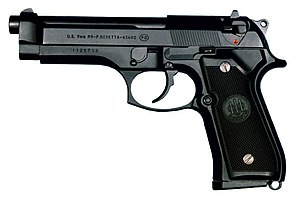This article needs additional citations for verification. (March 2023) |
| Pistol, Semiautomatic, 9mm, M9 | |
|---|---|
 | |
| Type | Semi-automatic pistol |
| Place of origin | United States, Italy |
| Service history | |
| In service | 1985–present[1] |
| Used by | United States Armed Forces |
| Wars | |
| Production history | |
| Designed | 1980s |
| Manufacturer | Beretta |
| Produced | 1985–present |
| Variants | M9A1, M9A2 (never released and cancelled) and M9A3 and M9A4 |
| Specifications | |
| Mass | Unloaded – 34.2 oz (970 g) |
| Length | 217 mm (8.5 in) |
| Barrel length | 125 mm (4.9 in) |
| Width | 38 mm (1.5 in)[2] |
| Height | 137 mm (5.4 in)[2] |
| Cartridge | 9×19mm Parabellum |
| Action | Short recoil, hinged locking piece assisted breechblock |
| Muzzle velocity | 381 m/s (1,250 ft/s) |
| Effective firing range | 50 m (55 yd) |
| Maximum firing range | 100 m (110 yd) |
| Feed system | Detachable box magazine; capacities:
Detachable drum magazine; capacity:
|
| Sights | Iron sights |
The Beretta M9, officially the Pistol, Semiautomatic, 9mm, M9, is the designation for the Beretta 92FS semi-automatic pistol used by the United States Armed Forces. The M9 was adopted by the United States military as their service pistol in 1985.
The 92FS won a competition in the 1980s to replace the M1911A1 as the primary sidearm of the U.S. military, beating many other contenders and only narrowly defeating the SIG Sauer P226 for cost reasons.[11] It officially entered service in 1990.[12] Some other pistols have been adopted to a lesser extent, namely the SIG P228 pistol, and other models remain in limited use.
The M9 was scheduled to be replaced under a United States Army program, the Future Handgun System (FHS), which was merged with the SOF Combat Pistol program to create the Joint Combat Pistol (JCP). The JCP was renamed Combat Pistol (CP), and the number of pistols to be bought was drastically cut back. The U.S. Army, Navy, Air Force, and Marine Corps are replacing the M9 with the SIG Sauer M17 and M18.[13]
- ^ Thompson, Leroy (2011). The Beretta M9 Pistol. Osprey Publishing. p. 75.
- ^ a b "Beretta M9". Beretta.
- ^ "Beretta 92FS Magazine 9mm 15rds". Beretta USA. Archived from the original on 24 January 2021. Retrieved 5 February 2021.
- ^ "Beretta M9A3 Sand Resistant Magazine 9mm 17rd". Beretta USA. Archived from the original on 26 January 2021. Retrieved 5 February 2021.
- ^ "Beretta 92FS 9mm 18-Round Magazine". GunMag Warehouse.
- ^ "Beretta 92FS Magazine 9mm 20rds". Beretta USA. Archived from the original on 21 January 2021. Retrieved 5 February 2021.
- ^ "Beretta 92FS CX4 Magazine 9mm 30rds". Beretta USA. Archived from the original on 1 February 2021. Retrieved 5 February 2021.
- ^ "ProMag Beretta 32 Round Magazine 9mm for Sale". ClassicFirearms.
- ^ "Red White & Blue Beretta 92 Magazine 9mm 35 Rounds Steel Black BER35RD". Cheaper Than Dirt.
- ^ https://grabagun.com/promag-beretta-92f-drum-9mm-luger-50-rounds-polymer-black-drm-a44.html
- ^ "Pistol Procurement, Allegations on Army Selection of Beretta 9mm as DOD Standard Sidearm" (PDF). General Accounting Office. June 1986. p. 18. Archived (PDF) from the original on 21 July 2011. Retrieved 11 February 2010.
- ^ "M-9 Pistol Fact File". U.S. Army. Archived from the original on 16 November 2013. Retrieved 25 December 2014.
- ^ "MHS Update: Services Embrace Army's New Sidearm". Military.com. 3 May 2017.